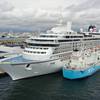According to the Homeland Security Department, between 2004 and 2007 it will have spent $10 billion on maritime security investments. However, industry and government officials say much remains to be done. One of the key concerns remains the Transportation Workers Identification Card, a program to provide a single biometric credential to be used at U.S. seaports, allowing transportation workers and seaport users to get just one security clearance and to be checked against terrorism databases anywhere nationwide. Begun in 2003 in a pilot effort, the program has been repeatedly delayed and has experienced cost overruns. Regulations for the program were initially due in 2004, but now are not likely until late in 2006. The federal government is still determining whether the Homeland Security Department will manage the program and issue the cards, or whether it will just publish a regulation and require individual ports or states to issue cards. Another concern has to do with a Ports Security Grant Program, in which private companies and port authorities apply to the federal government for grants to improve physical security at harbors. Congress has provided $175 million in grant money in 2006 but the Homeland Security Department has yet to release the funds, slowing security improvement to ports. The money is meant to cover some of the $5.6 billion needed overall for port security. Applications for grants since 2003 have outpaced grant money by about threefold. Another security system in place is the Automated Identification System, a system to provide real-time information on the identity, location, speed and course of vessels. AIS is only being used in 12 major ports and its coverage extends to only about 20 to 30 miles offshore. The Coast Guard is currently considering requiring all commercial vessels 65 feet or greater in length, including fishing and recreational vessels that are currently excluded from carriage requirements, to carry and operate AIS systems. But UPI reported the Coast Guard does not have the infrastructure or manpower to actually monitor the AIS as ships move in and out of American waters. The system costs about $10,000, and the cost is borne by the vessel operator. (Source: UPI)
Sponsored Content
Safer Starts Here: Build Ships, Protect Crews

July 2025
 Read the Magazine
Read the Magazine

 Read the Magazine
Read the Magazine
This issue sponsored by:

Rising Shipyard Stars: Ashley Cordiale's Journey from the Sea to Estimator at Detyens
Subscribe for
Maritime Reporter E-News
Maritime Reporter E-News is the maritime industry's largest circulation and most authoritative ENews Service, delivered to your Email five times per week









